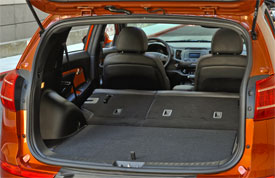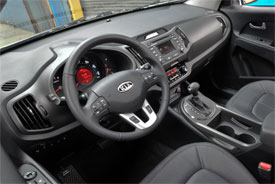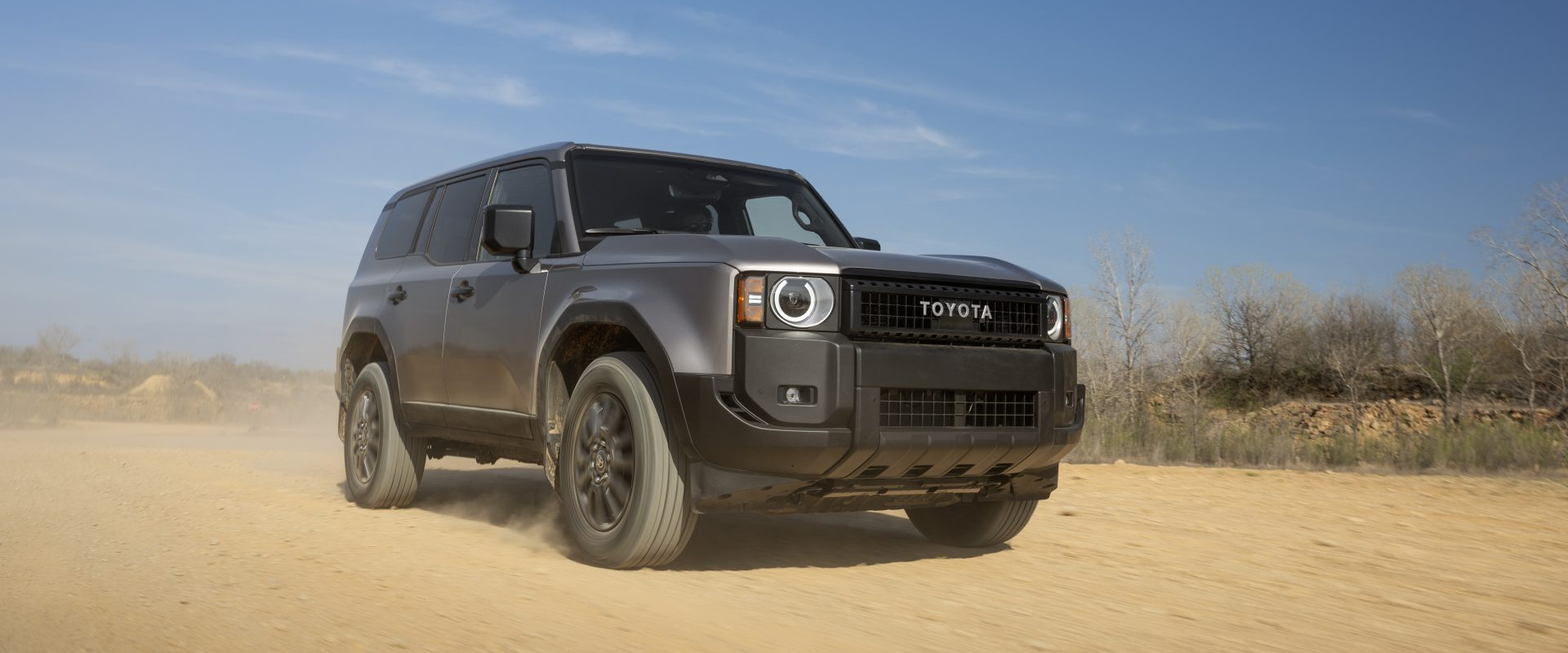In the past 18 months, Korean carmaker Kia has been a whirlwind, re-vamping their entire lineup, by either adding all-new models like the Soul and Forte, or totally re-engineering familiar names like the Sorento utility. Which, by the way, is also now made in the USA. So, it’s no wonder their Sportage compact crossover is next in line for a re-think. And, here’s what we think of that.
The 2011 Kia Sportage was definitely due for some time at the drawing board, but you might not recognize the refreshingly radical result. The bowtie-shaped Schreyer grille, named for the former Audi designer who has led Kia’s latest styling charge, transplants nicely onto the new Sportage’s Euro-chic coachwork, first seen on the 2007 Kue concept. The resemblance between design study and dealer lot is further evidenced in the Sportage’s concave sculpting above the rocker panels and the broad, chrome-edged C-pillars. Concentric brake and reverse lights wrap around the Sportage’s tall rear end from below each C-pillar to the heavily-contoured rear hatch. Standard alloy wheels are 16 inches, while our Sportage wore optional 18s.
 The interior design is more conservative, but still quite sporty. Sited among the hard plastics are large, hooded gauges set low in the cluster. Unusual for its class, push-button start is optional, and with it, a slot for the fob in the center armrest storage bin. The tilt-and-slide panoramic sunroof is available only with top EX trim.
The interior design is more conservative, but still quite sporty. Sited among the hard plastics are large, hooded gauges set low in the cluster. Unusual for its class, push-button start is optional, and with it, a slot for the fob in the center armrest storage bin. The tilt-and-slide panoramic sunroof is available only with top EX trim.
Bluetooth, USB, and aux audio input all come standard, and Kia’s new UVO infotainment system is optional. Our tester’s cooled driver’s seat, a segment first, is also available on Sportage EX.
There’s cozy but comfortable room for five, and trunk volume behind the 60/40 rear bench seat is up 10 percent to 26.1 cubic feet. But, drop the seats, and the radical styling results in twelve fewer cubes than before — 54.6. That’s less than both the Honda CR-V and Toyota RAV-4.
Power comes from the Forte SX, a 2.4-liter I4, good for 176 horsepower and 168 lb-ft of torque. Late in 2010, a 2.0-liter turbocharged and direct-injected I-4 will become an optional motor with around 270 horsepower. A six-speed manual transmission comes standard with front or all-wheel drive. Optional is Kia’s first in-house engineered six-speed automatic. As to all-wheel drive, the Kia Dynamax system is on-demand with all power going to the front wheels until needed. A locking center differential is included for more serious low speed needs.
Our Signal Red, all-wheel drive, 2.4-liter automatic tester had plenty of grip off the line, but still took a slow 10.4 seconds from zero to 60. Shifts were very smooth. The quarter mile was equally leisurely at 18 seconds and 80 mph. The 2.0 turbo should be a nice improvement.
 The all-wheel drive system aids in both traction and handling. Combined with standard electronic traction and stability control, the Sportage performs better than most rivals in our slalom tests. Typical of an all-wheel drive ute, there was a safe amount of cornering push and body roll, but you can still effectively manage exits with the throttle.
The all-wheel drive system aids in both traction and handling. Combined with standard electronic traction and stability control, the Sportage performs better than most rivals in our slalom tests. Typical of an all-wheel drive ute, there was a safe amount of cornering push and body roll, but you can still effectively manage exits with the throttle.
Braking is all-disc with ABS. Hard 60 to 0 stops averaged an acceptable 130 feet with a noticeable lateral twitch at the end. But the hardware faded little and never smoked.
The Sportage displayed an even more sporting character on public roads, where the weighty, precise steering response really shined. For tight quarters, the 34.7-foot turning diameter is impressive. Hill start assist and downhill brake control come standard for more than expected off-road abilities.
The new Kia Sportage really does live up to its name. It’s sporty and stylish. Now, there’s more engine noise than we’d like, but, with such an ample interior, this really is a very solid compact crossover contender. Government Fuel Economy ratings for our all-wheel drive Sportage automatic are 21 city, 28 highway. We averaged a fine 25.3 miles per gallon on regular gas. The Sportage earns an Energy Impact Score of 14.9 barrels of oil consumed annually, and leaves a Carbon Footprint of 8.1 tons of CO2.
On sale now, the well-equipped 2.4-liter Sportage starts at a very competitive $18,990. But options can push that to within a stone’s throw of thirty grand. All models include a high value 10-year, 100,000-mile powertrain warranty. For less than twenty grand, the 2011 Kia Sportage is just a great looking compact crossover deal. Even ten years ago, we couldn’t have seen this Kia coming, but we’re glad it’s here.
Specifications
- Engine: 2.4-Liter I4
- Horsepower: 176
- Torque: 168 Lb Feet
- 0-60 MPH: 10.4 Seconds
- 1/4 Mile: 18.0 Seconds @ 80 MPH
- 60-0 MPH: 130 Feet
- EPA: 21 MPG City/ 28 MPG Highway
- Mixed Loop: 25.3 MPG
- Energy Impact : 14.9 Barrels Oil/Yr
- CO2 Emissions: 8.1 Tons/Yr
Long Term Updates
Mileage: N/AThis all-wheel drive, compact crossover is already a staff hit both for its abilities to be an efficient crew hauler Monday-thru-Friday, and a fun kid-hauler on weekends.
The 176-horsepower 2.4-liter four-cylinder engine is plenty gutsy. Still, with average fuel economy of 22.0 miles per gallon of regular, there is room for improvement.
And that should happen as there are many summer vacation bound highway miles ahead for our friendly Kia Sportage.
Mileage: 3,000We’re all getting use to compact utilities becoming more common as fuel prices make larger crossovers less desirable for routine driving. The Kia Sportage is among the newest of the smallest, and it’s well posed to take advantage of this more miserly trend.
Larger SUV and utilities are hard pressed to break 20 miles per gallon around town. After 2 months and 3,000 miles we’re already averaging 22.3 in our Sportage. And, a recent race down to Florida and back delivered a highway average of nearly 28. All on the cheapest regular gas we could find.
The Sportage is more stiffly sprung than some rivals. So, you feel and hear every expansion joint. And the seats need more padding for long drives.
On the other hand, dodging semi-comatose drivers is a breeze. And, the agile Sportage parks easily. The 170-horsepower 2.4-liter four-cylinder is gutsy off the line, but it runs out of steam quickly. So, pass with care.
Still, if the Kia Sportage is utility reality at three-fifty gas, it’s fine with us.
Mileage: 8,000Our 2011 Sportage is a normally aspirated EX with optional all-wheel drive. It stickers for about $25,000 to start. Our test adds navigation and the Premium package with nice and durable leather upholstery for $30,000.
That buys a very modern, versatile, and quite efficient compact crossover. After 4 months and nearly 8,000 miles we’re averaging a fine 23.1 miles per gallon of regular. We’ve seen as high as 28 on the highway. The 176-horsepower 2.4-liter four-cylinder feels spritely, but does reach its limits quickly when trying to pass. It is agile, however, as the Sportage has a tighter suspension than most rivals, but also a slightly harsher ride. Made more so by seats that could use a little more padding. Still, it’s a very competent compact crossover that grows on us more every day.
Mileage: 10,000Our 2011 Kia Sportage EX has been with us for just under 6 months, and has absorbed about 10,000 miles of MotorWeek duties.
The powertrain is getting a little rougher, especially transmission shifts, but it’s nothing that points to a real problem.
Otherwise, it is performing both crew and personal-use duties extremely well. For a compact crossover, we are amazed at both its comfort and capacity.
Our normally aspirated, all-wheel drive Sportage is also reasonable on gas with a rising average of 24 miles per gallon of regular. And, that’s largely around suburbia. That’s also where the tighter than normal suspension of the Sportage really seems to shine.
Mileage: 11,300Webster’s Dictionary defines “workhorse” as “something that is markedly useful, durable, or dependable.” That pretty much sums up our feelings about the 2011 Kia Sportage EX Crossover that’s has been pulling duty with us for just over 7 months.
This sporty to see and reassuring to drive compact utility spends most of its time doing day trips for camera crew and staff. The wide rear cargo floor is a great work table in the field, even if the sloping roof means we have to fold the second row seats down for virtually all bulky cargo.
We noted before that the powertrain has gotten a rough edge, but that’s still the same with no hint of any real problem.
Calling the Sportage a workhorse is not totally fair, since it is also agile, solidly planted in corners, and comfortable for the longest trips.
Our normally aspirated, all-wheel drive Sportage is also reasonable on gas with an average of 23.7 miles per gallon of regular after 11,300 miles.
Now, it’s on to winter and the first real test of our Sportage’s all-wheel drive system. But, we’re pretty sure that it too will live up to the workhorse definition.
Mileage: 13,000Consumers are also flocking to Kia, and our all-wheel drive 2011 Sportage EX shows us why. It’s sporty, agile yet surefooted, with a very comfortable, well laid out, if, stark, interior.
After 8 months and 13,000 miles, fuel economy has settled in at 23.2 miles per gallon of regular in mostly urban driving. But, highway driving is in the high 20s.
No new issues from the standard 176-horsepower 2.4-liter; it’s quite willing. Also the slight engine roughness we mentioned earlier has not grown worse. Good to know that like all Kia’s it’s protected by a 10 year/100,000 mile power train warranty.
Mileage: 14,000A quick trip down I-95 for President’s Day brought to the fore all the reasons we like our all-wheel drive 2011 Sportage EX, as well as a couple of issues.
On the plus side, it’s agile and also provides a very stable long distance ride. On the inside, there is an ample cargo bay, as well as good small item storage, with conveniently placed power and connectivity ports.
Fuel economy is quite acceptable too. Our 9 month average over nearly 14,000 miles is 22.7 and reflects a lot of stop and go driving. Yet, at Interstate Speeds, 26 miles per gallon of regular is typical.
On the down side, a smallish, 14 and a half gallon gas tank means more frequent fill ups. And, at slower speeds on rough pavement the ride borders on uncomfortable, with rear seat occupants getting the worst of it.
But, were we ever glad our Sportage has all-wheel drive as we made in home in a freak snow storm that left others sliding. So, our mostly happy times with the Kia Sportage are continuing into spring.
Mileage: 15,000Some 3500 Kia Sportage compact crossover utilities hit American roads each month. And, after spending 10 months with our long term all-wheel drive 2011 Sportage EX, it’s clear why. The Sportage is a very sharp looking five passenger ute that has great personality and puts sporty handling high on its list of capabilities. That’s not to say it’s perfect however. On long trips, those up front are treated well. But, in the rear seats, especially on bumpy roads, it’s not all that comfortable.
Fuel economy from the standard 2.4-liter engine is on the mark. After 15,000 miles our test 23.7 miles per gallon of regular closely matches the government’s combined rating. We truly enjoy the roomy interior and it’s rather serious, mostly black tone. Kia’s optional navi system with backup camera is first rate. Seats up, the cargo bay is just big enough. Seats down, and you can stuff a lot into a Sportage. Plus, the Sportage can tow small trailers up to 2,000 pounds. But, the best part. The Kia Sportage is never boring to drive.
Mileage: 22,000From the Kia side of Korea’s largest carmaker comes our Sportage EX compact crossover utility. We’re closing in on a year with this all-wheel drive Sportage, and it has truly lived up to its name. Only a few affordable CUVs are fun to drive and this is one of them.
After 22,000 miles, overall fuel economy from the standard 2.4-liter is quite good for its class at 23.4 miles per gallon of regular. Adult comfort is great up front while the second row is more for kids and teens who might not mind the tight fit and thin padding. The sloping roof line also limits bulky cargo hauling, while the load floor itself is wide, long, and uncluttered. One more reason we support the Sportage as an excellent compact utility choice.







 The interior design is more conservative, but still quite sporty. Sited among the hard plastics are large, hooded gauges set low in the cluster. Unusual for its class, push-button start is optional, and with it, a slot for the fob in the center armrest storage bin. The tilt-and-slide panoramic sunroof is available only with top EX trim.
The interior design is more conservative, but still quite sporty. Sited among the hard plastics are large, hooded gauges set low in the cluster. Unusual for its class, push-button start is optional, and with it, a slot for the fob in the center armrest storage bin. The tilt-and-slide panoramic sunroof is available only with top EX trim. The all-wheel drive system aids in both traction and handling. Combined with standard electronic traction and stability control, the Sportage performs better than most rivals in our slalom tests. Typical of an all-wheel drive ute, there was a safe amount of cornering push and body roll, but you can still effectively manage exits with the throttle.
The all-wheel drive system aids in both traction and handling. Combined with standard electronic traction and stability control, the Sportage performs better than most rivals in our slalom tests. Typical of an all-wheel drive ute, there was a safe amount of cornering push and body roll, but you can still effectively manage exits with the throttle.